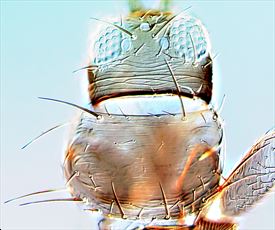Distinguishing features
Both sexes fully winged. Female colour brown to dark brown, anterior margin of head paler also pronotum; antennal segment V dark; fore wings usually densely shaded. Antennae 8-segmented, III & IV each with sense cone forked, VIII longer than VII. Head wider than long; 3 pairs of ocellar setae present, pair III longer than distance between external margins of hind ocelli, arising near anterior margins of ocellar triangle; postocular setae pair I present, pair IV longer than distance between hind ocelli. Pronotum with 5 pairs of major setae; anteromarginal setae slightly shorter than anteroangulars, one pair of minor setae present medially between posteromarginal submedian setae. Metanotum with 2 pairs of setae at anterior margin, campaniform sensilla usually present. Hind coxae with group of stout microtrichia on dorsal surface. Fore wing with 2 complete rows of veinal setae. Tergites V–VIII with paired lateral ctenidia, on VIII anterolateral to spiracle; posteromarginal comb on VIII complete, with long slender microtrichia that are usually as long as the median setae on tergite VI. Sternites III–VII without discal setae.
Male similar to female but yellow; tergite VIII with posteromarginal comb; IX with median pair of dorsal setae shorter than lateral pair; sternites III–VII with transverse pore plate.
Related species
Only two species of Frankliniella are currently recorded from New Zealand: F. occidentalis and F. intonsa. However, F. panamensis is very similar in structure to occidentalis, and is regularly intercepted in quarantine. It is generally darker than occidentalis, with the comb on tergite VIII longer and a group of stout microtrichia on the upper surface of the hind coxae (Gunawardana et al., 2017). Frankliniella species all have a pair of setae in front of the first ocellus, a complete row of setae on both veins of the fore wing, and a pair of ctenidia on tergite VIII situated anterolateral to the spiracles. Most of the 230 described species are known only from the neotropics, but F. schultzei and F. occidentalis have been widely introduced around the world (Kirk & Terry, 2003).
Biological data
This is a polyphagous species that feeds and breeds within flowers and possibly also on leaves. Although widely disseminated from Colombia by the horticultural trade, it is not yet recorded as a pest or virus vector.
Distribution data
Commonly found between Costa Rica and Colombia particularly in montane areas, but regularly intercepted in quarantine in New Zealand, Australia, and Japan in imported flowers.
Family name
THRIPIDAE, THRIPINAE
Species name
Frankliniella panamensis Hood
Original name and synonyms
Frankliniella panamensis Hood, 1925: 76
Frankliniella stylosa colombiensis Moulton, 1948: 99.
References
Gunawardana DN, Li DM, Masumoto M, Mound LA, O’Donnell CA & Skarlinsky TL. (2017) Resolving the confused identity of Frankliniella panamensis (Thysanoptera: Thripidae). Zootaxa 4323 (1): 125–131.
Kirk WDJ & Terry LI (2003) The spread of the Western flower thrips Frankliniella occidentalis (Pergande). Agricultural and Forestry Entomology 5: 301–310.
Mound LA & Marullo R (1996) The Thrips of Central and South America: An Introduction. Memoirs on Entomology, International 6: 1–488.



